Gymnosperms are primitive seed-producing plants of Spermatophytes (Phanerogams). They are ‘Naked-Seed’ Plants. The term is derived from two Greek words: ‘gymnos’ meaning naked and ‘sperma’ meaning seeds. They are characterized by naked ovules (i.e., ovule without the ovary). The ovules of Gymnosperms are borne directly on the surface of the megasporophyls. Unlike Angiosperms, in Gymnosperms the seeds are NOT enclosed in the fruit. Thus the Gymnosperms are also known as “Phanerogams without ovary”. The present post discusses the General Characteristics of Gymnosperms.
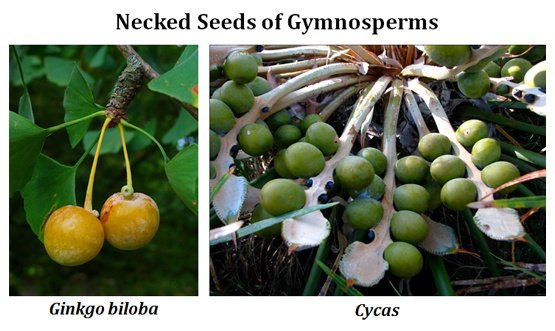
General Characteristics of Gymnosperms
Distribution
Ø Gymnosperms are a small ancient group of seed plants consisting of 83 genera and 1080 species.
Ø Distribution: Temperate and Tropical regions.
Ø Gymnosperms were originated in the Paleozoic Era (541 – 252 million years ago).
Ø They were the dominant plants of Jurassic and Cretaceous periods of the Mesozoic era.
Ø Many primitive Gymnosperms were extinct.
Ø Examples of extinct Gymnosperms: Cycadofilicales, Bennettitales, Cordaitales
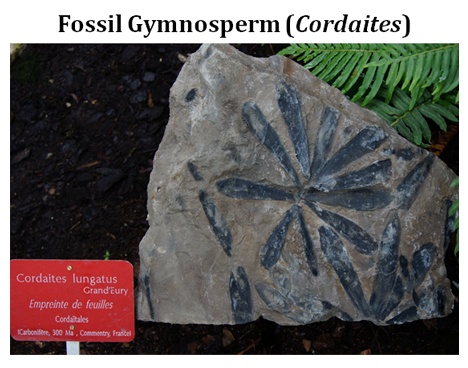
Examples of Gymnosperms
Ø Cycas, Pinus, Gnetum, Zamia, Ephedra, Welwitschi, Podocarpus, Taxus, Cedrus, Abies, Araucaria
Morphological Characteristics
Ø The plant body is sporophytic (diploid) and differentiated into roots, stem and leaves.
Ø Present day gymnosperms are usually evergreen trees or shrubs.
Ø They usually show xerophytic characters.
Ø The roots show symbiotic association with fungi or cyanobacteria.
Ø Fungi forms mycorrhizal association with the roots of Pinus. The mycorrhiza helps in the absorption of minerals.
Ø Algae (Cycas and Nostoc) inhabited in the coralloid roots of Cycas helps in nitrogen fixation.
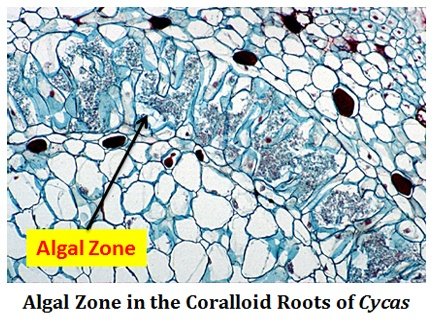
Ø The stem is usually erect, branched and woody. Stem is usually un-branched in Cycas and it is underground in Zamia.
Ø Presence of permanent leaf scar is a characteristic feature of Gymnosperms.
Ø Leaves are usually dimorphic (two types of leaves in the same plant).
Ø They are (a) Foliage leaves and (b) Scale leaves.
Ø The foliage leaves are green; simple or needle-shaped or pinnately compound.
Ø Scale leaves are minute and deciduous.
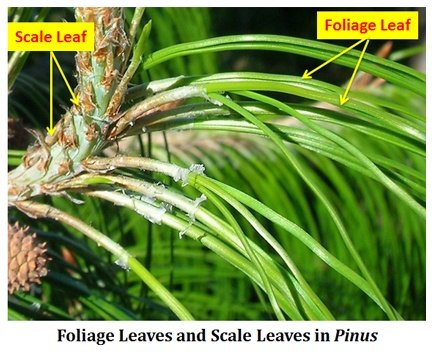
Ø Cycas show circinate vernation (young leaves curved inward).
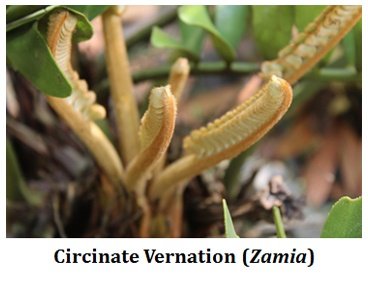 Ø Presence of circinate vernation in Cycas is a strong evidence for the Pteridophytic origin of Gymnosperms. Cycas acts as the connecting link between Pteridophytes and Gymnosperms.
Ø Presence of circinate vernation in Cycas is a strong evidence for the Pteridophytic origin of Gymnosperms. Cycas acts as the connecting link between Pteridophytes and Gymnosperms.
Anatomical Characteristics
Ø The leaves of Gymnosperms have very thick cuticle.
Ø Mesophyll is differentiated into palisade and spongy tissues.
Ø Mesophyll is undifferentiated in Pinus.
Ø Leaves do NOT have lateral veins.
Ø Lateral translocation of nutrients takes place through transfusion tissue.
Ø Stomata usually sunken type (to reduce the transpiration).
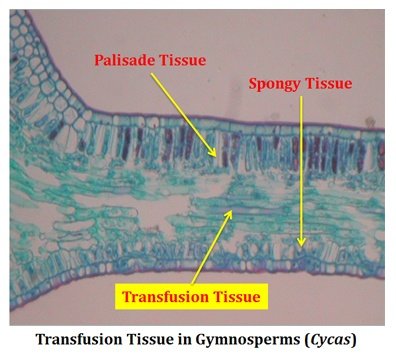
Ø Gymnosperms possess well developed vascular system.
Ø Vascular bundles are collateral and open.
Ø The vascular system consists of xylem and phloem.
| You may also like NOTES in... | ||
|---|---|---|
| BOTANY | BIOCHEMISTRY | MOL. BIOLOGY |
| ZOOLOGY | MICROBIOLOGY | BIOSTATISTICS |
| ECOLOGY | IMMUNOLOGY | BIOTECHNOLOGY |
| GENETICS | EMBRYOLOGY | PHYSIOLOGY |
| EVOLUTION | BIOPHYSICS | BIOINFORMATICS |
Xylem
Ø Xylem consists of Tracheids and Parenchyma
Ø Vessels are absent in the xylem.
Ø Vessels present in the xylem of Gnetum.
Ø Presence of vessels in the wood of Gnetum is a strong evidence for the Gymnospermic origin of Angiosperms. Gnetum is a connecting link between Gymnosperms and Angiosperms.
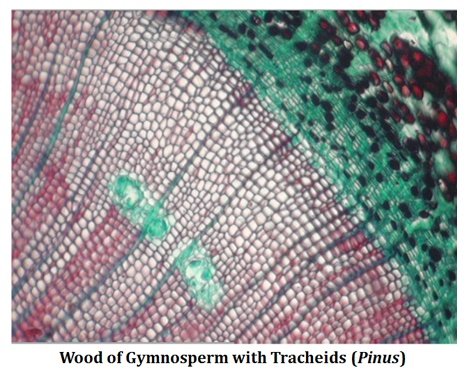
Phloem
Ø Phloem consists of sieve tubes and phloem parenchyma.
Ø Companion cells are absent in Gymnosperms
Ø Stem shows secondary growth.
Ø The wood may be manoxylic (Cycas) or pycnoxylic (Pinus)
Ø Tanniniferous cells present in the cortex.
Ø Roots are diarch (two vascular bundles) to polyarch (many vascular bundles).
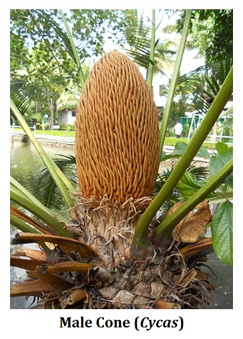 Reproduction in Gymnosperms
Reproduction in Gymnosperms
Ø Gymnosperms are heterosporous.
Ø Megasporangia are produced on megasporophylls.
Ø Microsporangia are produced on microsporophylls.
Ø Sporophylls aggregated to form cones or strobili.
Ø Cones/strobili are mono-sporangiage.
Male cone, Microsporophylls and Microspores
Ø Male cones in Gymnosperms are short-lived whereas; the female cones live for many years.
Ø Microsporangia are formed on the abaxial side of microsporophyll.
Ø Microsporangial development is eusporangiate type.
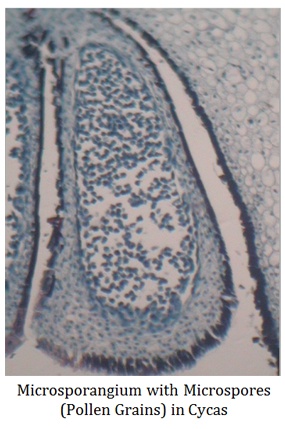
Female cone, Megasporophyll and Ovule
Ø Female cone is formed by the aggregation of megasporophylls.
Ø The megasporophylls may be foliar as in Cycas or cauline (woody) as in Pinus.
Ø The megasporangium is better known as the ovule.
Ø Ovules are orthotropous and unitegmic.
Ø Ovular integument in Gymnosperms is differentiated into three layers.
Pollination and Fertilization
Ø Pollination: all gymnosperms are wind pollinated (Anemophily)
Ø Microspores are liberated at various stages of the male gametophyte.
Ø Pollens deposited in the wet pollen chamber
Ø Fertilization siphonogamous (with the help of pollen tube).
Ø The pollen tube functions as the sperm carrier.
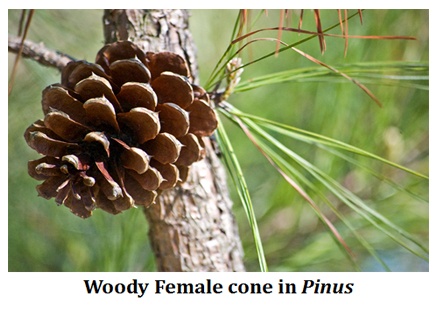
Ø Male gametes are non-motile except in Cycas and Ginkgo
Ø Number of archegonia in the female gametophyte varies.
Ø There are several archegonia in Cycas whereas only one in Pinus.
Ø Archegonium has a single egg and a venter canal cell.
Ø Archegonium in Gnetum is represented by ovum only.
Ø Neck canal cell are absent in Gnetum.
Ø Embryo development is meroblastic (embryo develops from some part of zygote. Angiosperms also show meroblastic development).
Ø Endosperm is present in the seeds of Gymnosperms.
Ø The development of endosperm takes place before the fertilization
Ø Endosperm in gymnosperm is haploid (since it is the part of female gametophyte).
Ø Double fertilization and triple fusion are absent in Gymnosperms.
Ø Polyembryony is very common in Gymnosperms.
Ø Polyembryony may arise by (a) Fertilization of more than one egg or by (b) Division of the zygote (Cleavage polyembryony).
Ø Seed coat present. Integument of the ovule forms the seed coat.
Ø Seeds are winged and light-weight in Pinus (for wind dispersal).
Ø Number of cotyledons in the seeds may be one or two or many.
Ø Gymnospermic seeds usually have a resting period.
Ø Distinct alternation of generation is present in Gymnosperms.
Ø Diploid sporophytic generation is the dominant phase.
Ø Haploid gametophytic stage is highly reduced
Ø Gametophytic phase is depended on sporophytic phase.
| You may also like... | ||
|---|---|---|
| NOTES | QUESTION BANK | COMPETITIVE EXAMS. |
| PPTs | UNIVERSITY EXAMS | DIFFERENCE BETWEEN.. |
| MCQs | PLUS ONE BIOLOGY | NEWS & JOBS |
| MOCK TESTS | PLUS TWO BIOLOGY | PRACTICAL |
You might also like…
@. Pteridophytes General Characteristics
@. Bryophytes General Characteristics
@. Algae General Characteristics
@. Fungi General Characteristics

Sir link of this classification kindly send me